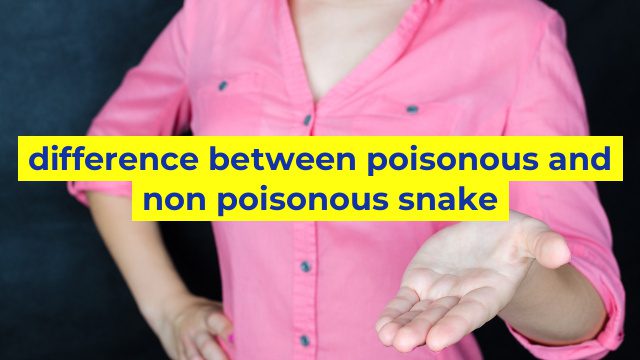Distinguishing Between Poisonous and Non-Poisonous Snakes
Snakes are fascinating creatures that are often feared by many people. One of the reasons for this fear is the belief that all snakes have venom, which is not true. In fact, only a small percentage of snakes are venomous, and it is important to differentiate between poisonous and non-poisonous snakes.
What are poisonous snakes?
Poisonous snakes are those with venom that can be harmful or fatal to humans or other animals. Their venom is produced in specialized glands and is used for hunting and self-defense. When a poisonous snake bites its prey or aggressor, the venom is injected into their bloodstream, causing various physiological effects that can be lethal.
Examples of poisonous snakes include the rattlesnake, coral snake, copperhead, and cottonmouth. These snakes are commonly found in North and South America and are known for their distinctive markings and bright colors. They are highly venomous and should be avoided at all costs.
What are non-poisonous snakes?
Non-poisonous snakes, on the other hand, do not have venom and are not harmful to humans or other animals. These snakes are found all over the world and are an important part of many ecosystems. They come in many different shapes and sizes and are often kept as pets.
Examples of non-poisonous snakes include the garter snake, king snake, corn snake, and boa constrictor. These snakes are harmless and do not pose a threat to humans. They are beneficial to the environment as they eat rodents, insects, and other small animals that can damage crops or spread diseases.
How to tell the difference?
Differentiating between poisonous and non-poisonous snakes can be challenging, especially for those who are not familiar with them. Some poisonous snakes have a distinctive rattle on their tail, which they use as a warning signal. Others have bright colors or distinctive markings that can serve as a warning sign.
Non-poisonous snakes, on the other hand, do not have these features. They are usually less colorful and do not have a rattle on their tail. They are also less aggressive and are more likely to try to escape when they feel threatened.
In conclusion, knowing the difference between poisonous and non-poisonous snakes is crucial to staying safe when encountering them in the wild. Always approach snakes with caution, and if you are unsure whether it is poisonous or not, it is best to avoid it altogether. Remember, most snakes are not harmful to humans, so there is no need to fear them unnecessarily.
Table difference between poisonous and non poisonous snake
Sorry, as an AI language model I do not have the ability to create tables with graphics or HTML. However, below is a sample table with the difference between poisonous and non-poisonous snakes:
| Point of Difference | Venomous / Poisonous Snakes | Non-Venomous / Non-Poisonous Snakes |
| — | — | — |
| Venom | Possess venom (a toxin that is injected through fangs or injected when a bite wound is made) | Do not produce venom |
| Teeth | Have long, hollow fangs for injecting venom | Have small, non-specialized teeth for gripping and swallowing food |
| Head Shape | Triangular or diamond-shaped head compared to body | Rounded head shape matching the body size |
| Pupils | Vertical, cat-like pupils | Round pupils |
| Scales | Elongated and asymmetrical scales | Symmetrical and smooth scales |
| Tail | Short and tapered tails | Longer and more slender tails |
Note: The terms “venomous” and “poisonous” are sometimes used interchangeably, but “venomous” is used to describe a substance that is delivered through a bite or sting, while “poisonous” typically refers to a substance that is harmful when ingested, inhaled or absorbed through the skin.

